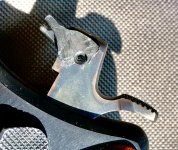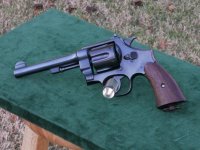"....Also, do you believe the firing pin that broke on me was the original from the conversion or a later replacement? It seems like someone wouldn't go through all the work just to put in a mis-measured part.
From what I understand you're also saying a replacement pin would need to be a newly made part or a customized factory pin?
Would this work with modifacation?..."
Just my guess is that the firing pin is the original one made at the time of the conversion.
It would have to be a hand-made part as the need for the geometry is that the actual nose of the FP is up higher than on a standard CF firingpin for that hammer & frame.
It could have taken use for a long time before breaking.
I'm just thinking it likely was dry firing may have broke it.
That xposed a small fitting flaw that may have allowed the FP to take the impact of the falling hammer instead of the shoulders of the hammer itself onto the frame.
All speculation for sure.
That broken firing pin,, use it as a pattern for a new one.
A new FP is a simple make out of sheet tool steel. The old one traced
carefull around on it gives you a big headstart towards completion.
Drill the rivit hole first and work out shaping it from there.
The broken off piece of the orig is probably still trapped in the slot in the hammer. Drive the rivit out, the small remaining piece will probably fall out.
The rivit can usually be re-used if taken care with.
I'd leave the new pin a little generous in size around the point when made for extra fitting. The point may have to be angled slightly different, some taken off the top, etc
Then it's just a matter if 'try, cut & fit' to get it right.
The frame tunnel for the pin may need a little attention as well.
I'd harden the pin and then draw it back enough so it's not brittle but still tough enough for the job.
From what I understand you're also saying a replacement pin would need to be a newly made part or a customized factory pin?
Would this work with modifacation?..."
Just my guess is that the firing pin is the original one made at the time of the conversion.
It would have to be a hand-made part as the need for the geometry is that the actual nose of the FP is up higher than on a standard CF firingpin for that hammer & frame.
It could have taken use for a long time before breaking.
I'm just thinking it likely was dry firing may have broke it.
That xposed a small fitting flaw that may have allowed the FP to take the impact of the falling hammer instead of the shoulders of the hammer itself onto the frame.
All speculation for sure.
That broken firing pin,, use it as a pattern for a new one.
A new FP is a simple make out of sheet tool steel. The old one traced
carefull around on it gives you a big headstart towards completion.
Drill the rivit hole first and work out shaping it from there.
The broken off piece of the orig is probably still trapped in the slot in the hammer. Drive the rivit out, the small remaining piece will probably fall out.
The rivit can usually be re-used if taken care with.
I'd leave the new pin a little generous in size around the point when made for extra fitting. The point may have to be angled slightly different, some taken off the top, etc
Then it's just a matter if 'try, cut & fit' to get it right.
The frame tunnel for the pin may need a little attention as well.
I'd harden the pin and then draw it back enough so it's not brittle but still tough enough for the job.



